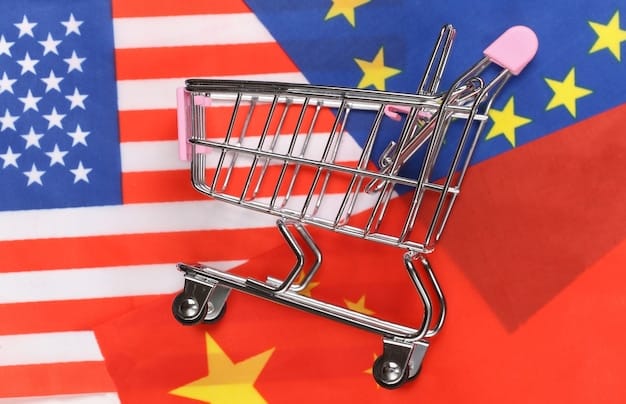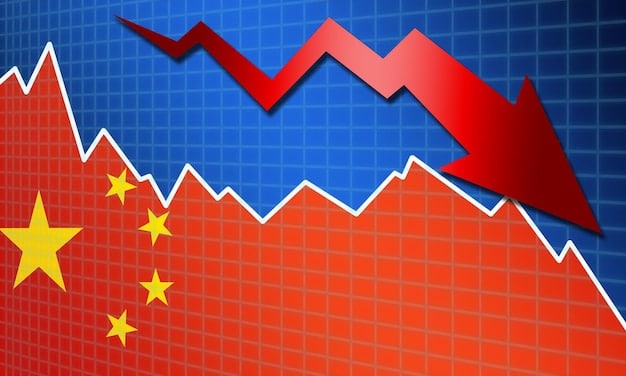US-China Trade War: Impact of 15% Tariffs on American Consumers

The US-China trade war, particularly the imposition of a 15% tariff, significantly impacts American consumers through increased prices and economic uncertainty, affecting various sectors and purchasing power.
The **US-China Trade War: Analyzing the 15% Tariff Increase and Its Implications for American Consumers** has been a major point of discussion in global economics, directly impacting the cost of goods and services for the average American family. These tariffs, essentially taxes on imported goods, reshape trade relationships and can lead to higher prices on everyday products.
Understanding the US-China Trade War
The US-China trade war is an ongoing economic dispute between the United States and China. It began in 2018, when the Trump administration imposed tariffs on Chinese goods with the goal of reducing the trade deficit, protecting American intellectual property, and promoting fair trade practices.
The conflict quickly escalated, with both countries imposing tariffs on billions of dollars worth of goods. The 15% tariff increase is one significant aspect of this broader trade war.

Origins of the Trade War
The roots of the US-China trade war lie in long-standing grievances over trade imbalances and intellectual property theft. The US has long argued that China engages in unfair trade practices, including currency manipulation and the theft of American technology. The trade war was intended to address these concerns.
- Trade Imbalance: The persistent trade deficit between the US and China.
- Intellectual Property: Allegations of IP theft and inadequate protection.
- Market Access: Restrictions on American companies operating in China.
The trade war aimed to force China to change its trade practices, but it has had broader effects on the global economy.
The 15% Tariff Increase: A Closer Look
The 15% tariff increase involves imposing a 15% tax on a specific range of Chinese goods entering the US market. These tariffs are designed to make imported goods more expensive, potentially incentivizing American consumers and businesses to purchase domestically produced alternatives.
However, the reality is often more complex, as increased costs can be passed on to consumers, affecting their purchasing power.
Goods Affected by the Tariffs
The 15% tariff increase impacts various sectors. A wide range of goods, from electronics and clothing to machinery and agricultural products, have been subject to these tariffs. This broad scope means that many everyday items that American consumers buy are affected.
Understanding which goods are most affected can provide insight into the potential economic impact.
- Electronics: Smartphones, laptops, and other consumer electronics.
- Apparel: Clothing, shoes, and accessories.
- Machinery: Industrial equipment and components.
- Agricultural Products: Certain food items and agricultural commodities.
The diversity of these goods means that the tariffs touch many aspects of American life.
Impact on American Consumers
The primary concern for American consumers is the potential for rising prices. When tariffs increase the cost of imported goods, retailers often pass those costs onto consumers in the form of higher prices.
This can reduce purchasing power and affect household budgets.

Price Increases and Inflation
Tariffs contribute to inflation by raising the cost of imported goods. If businesses have to pay more for inputs and materials, they may increase prices to maintain their profit margins. This can lead to a broad-based increase in the cost of living.
The extent of these price increases varies depending on the product and the ability of businesses to absorb the costs.
Consumers may face higher prices for:
- Clothing and Apparel
- Home Goods
- Electronics
These price changes can add up, affecting a consumer’s ability to spend on other goods and services.
Economic Implications for the US
Beyond the immediate impact on consumers, the US-China trade war has broader economic implications. It affects businesses, investment, and overall economic growth.
These broader implications can lead to uncertainty and volatility in the market.
Business and Investment
The trade war creates uncertainty for businesses that rely on trade between the US and China. Companies may face higher costs, disrupted supply chains, and reduced access to markets. This can lead to decreased investment and slower economic growth.
Companies may consider:
- Relocating production to avoid tariffs
- Finding alternative suppliers
- Reducing investment due to uncertainty
These adjustments can be costly and time-consuming, impacting overall business performance.
Potential Winners and Losers
While the tariffs generally lead to higher costs, some sectors may benefit. Industries that compete with Chinese imports could see increased demand for their products, as the tariffs make those imports less competitive.
However, the overall impact is complex, and even potential winners may face challenges.
Sectors that Might Benefit
Domestic industries that produce goods similar to those subject to tariffs may see an increase in sales. For example, if tariffs are imposed on imported steel, American steel producers may benefit.
Potential beneficiaries include:
- Domestic steel producers
- American agricultural producers
- Companies that manufacture goods domestically
These gains may be offset by other factors, such as higher input costs and reduced export opportunities.
Strategies for Consumers and Businesses
Given the complexities of the US-China trade war, consumers and businesses need strategies to mitigate its impact. This includes exploring alternative products, adjusting supply chains, and advocating for policy changes.
Being proactive can help minimize the negative consequences of the trade war.
Adapting to the New Reality
Consumers can look for less expensive alternatives to goods affected by tariffs. Businesses can explore alternative suppliers and adjust their strategies to navigate the changing trade landscape.
Possible strategies:
- Explore domestic alternatives
- Find suppliers in other countries
- Advocate for policy change
These adaptations can help soften the blow of the tariffs.
| Key Point | Brief Description |
|---|---|
| 💰 Higher Prices | Tariffs increase import costs, leading to higher prices for consumers. |
| 🏭 Business Impact | Businesses face increased costs, supply chain disruptions, and investment uncertainty. |
| 📈 Inflation Risk | Tariffs contribute to inflation by increasing the cost of goods and services. |
| 🌍 Sectoral Winners | Domestic industries competing with Chinese imports may experience higher demand. |
FAQ
▼
The US-China Trade War is an economic dispute between the United States and China initiated in 2018. It involves tariffs on goods exchanged between the two countries, affecting various sectors.
▼
The 15% tariff increases the cost of imported goods from China, which often leads to higher prices for consumers. This can impact household budgets and overall spending.
▼
Goods like electronics, clothing, machinery, and some agricultural products are significantly affected. These are common items that many American consumers purchase regularly.
▼
Businesses can try to mitigate the impact by finding alternative suppliers, relocating production, or advocating for a change in trade policies. The most proactive may also fare better.
▼
Some domestic industries that compete with Chinese imports might benefit from increased demand for their products. However, the overall economic impact is complex and mixed.
Conclusion
The US-China trade war, particularly the 15% tariff increase, has multifaceted implications for American consumers and the US economy as a whole. With careful planning and adaptation, consumers and businesses can better navigate these challenges and minimize potential negative impacts.





